Peru’s Violent Protests Imperil 30% of Its Copper Output
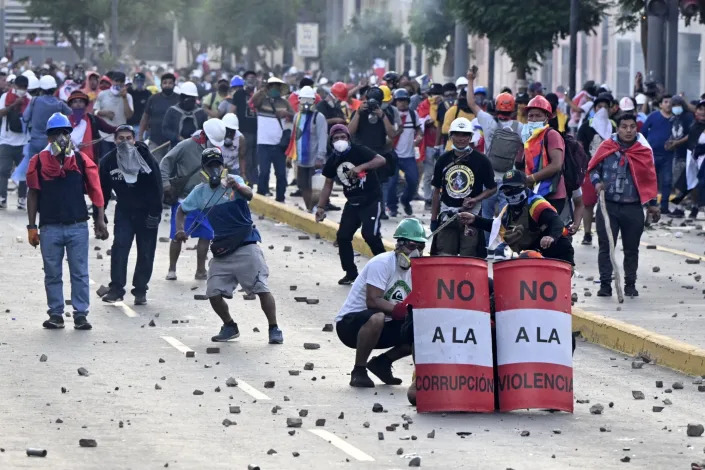
James Attwood
Fri, January 27, 2023
(Bloomberg) -- An upsurge in the violent protests wracking Peru is crimping copper output in the world’s No. 2 supplier, with about 30% of its production at risk at a time of low global stocks and high prices.
One copper mine is offline after demonstrators stormed the site, another has seen shipments choked by roadblocks, while others have slowed operations as a precaution to manage scarce supplies of fuel and other inputs, according to industry group SNMPE.
“The situation of protests and the escalation of violence have affected the industry,” Magaly Bardales, who heads a mining sector committee at the association, said in a telephone interview. “We hope an understanding, a dialog with authorities, can be found to provide a swift solution.”
Demonstrators have blocked roads across Peru and clashed with security forces in more than six weeks of violent turmoil that began when President Pedro Castillo was impeached after he attempted to dissolve congress. Protesters are calling for both interim President Dina Boluarte and congress to be replaced, with more than 50 deaths and the violence showing no signs of easing.
The disruption coincides with operational setbacks and regulatory headwinds in neighboring Chile and the prospect of a mine shutdown in Panama as the government there seeks a bigger share of profit. Those supply threats have combined with optimism over Chinese demand after the lifting of Covid restrictions to send copper futures to seven-month highs.
With global stockpiles of the wiring metal at historically low levels, traders are keeping close watch on events in Peru. The Andean nation accounts for about a 10th of global copper supply and is a major exporter of zinc and silver. About $160 million of production has been lost in 23 days of protests, Bardales said.
To be sure, protests are nothing new in Peru. It’s emergence as a major mineral producer has exacerbated historically tense relations with poor rural communities. The mining industry says not enough of the record-high revenue it generates for the state goes to improving local infrastructure and services.
But the current wave of unrest stands out from past events.
“I haven’t seen this level of violence, the coordinated nature of action, seeking to affect mining and energy, during the time I have been working in the sector,” Bardales said.
Much of the unrest is centered in the southern region of Puno, where Minsur SA’s San Rafael tin mine has been targeted. About 1,500 workers at San Rafael still can’t be evacuated, she said.
Tensions have fanned out into other areas of the south including Espinar, Arequipa and Cusco. Glencore Plc’s Antapaccay mine has halted operations after protesters entered and damaged a worker camp.
The Las Bambas complex is mining at a reduced rate due to blockade-related supply challenges, its Chinese-owned operator MMG Ltd. said, without elaborating. Bardales said Las Bambas is operating at just 20% of capacity, even as it continues to process ore on site.
The Cerro Verde mine in Arequipa isn’t being directly affected by protests but it has slowed mill operations by 10-15% in the past several days in a bid to conserve supplies such as lime amid a “very complicated” political situation, operator Freeport-McMoRan Inc. said this week on an earnings call.
Other mines to the north, such as BHP Group-Glencore’s Antamina are running normally, as are mines in the south that don’t depend on the so-called mining corridor for the transport of supplies, copper and people.
While the transport of semi-processed copper to ports has seen some disruption, the ports themselves are operating normally, Bardales said. She hadn’t heard of any “relevant” impacts on shipments.
The mining society continues to project an increase in Peruvian copper production this year as a new mine ramps up, although much depends on how long the current spate of protests lasts.
The unrest also jeopardizes the rollout of $53.7 billion in possible investments at a time when the world needs to accelerate decarbonization and boost minerals required for electromobility, according to BTG Pactual analyst Cesar Perez-Novoa.
“The combination of instability in other jurisdictions may exert upward pressure on copper prices,” Perez-Novoa said.

James Attwood
Fri, January 27, 2023
(Bloomberg) -- An upsurge in the violent protests wracking Peru is crimping copper output in the world’s No. 2 supplier, with about 30% of its production at risk at a time of low global stocks and high prices.
One copper mine is offline after demonstrators stormed the site, another has seen shipments choked by roadblocks, while others have slowed operations as a precaution to manage scarce supplies of fuel and other inputs, according to industry group SNMPE.
“The situation of protests and the escalation of violence have affected the industry,” Magaly Bardales, who heads a mining sector committee at the association, said in a telephone interview. “We hope an understanding, a dialog with authorities, can be found to provide a swift solution.”
Demonstrators have blocked roads across Peru and clashed with security forces in more than six weeks of violent turmoil that began when President Pedro Castillo was impeached after he attempted to dissolve congress. Protesters are calling for both interim President Dina Boluarte and congress to be replaced, with more than 50 deaths and the violence showing no signs of easing.
The disruption coincides with operational setbacks and regulatory headwinds in neighboring Chile and the prospect of a mine shutdown in Panama as the government there seeks a bigger share of profit. Those supply threats have combined with optimism over Chinese demand after the lifting of Covid restrictions to send copper futures to seven-month highs.
With global stockpiles of the wiring metal at historically low levels, traders are keeping close watch on events in Peru. The Andean nation accounts for about a 10th of global copper supply and is a major exporter of zinc and silver. About $160 million of production has been lost in 23 days of protests, Bardales said.
To be sure, protests are nothing new in Peru. It’s emergence as a major mineral producer has exacerbated historically tense relations with poor rural communities. The mining industry says not enough of the record-high revenue it generates for the state goes to improving local infrastructure and services.
But the current wave of unrest stands out from past events.
“I haven’t seen this level of violence, the coordinated nature of action, seeking to affect mining and energy, during the time I have been working in the sector,” Bardales said.
Much of the unrest is centered in the southern region of Puno, where Minsur SA’s San Rafael tin mine has been targeted. About 1,500 workers at San Rafael still can’t be evacuated, she said.
Tensions have fanned out into other areas of the south including Espinar, Arequipa and Cusco. Glencore Plc’s Antapaccay mine has halted operations after protesters entered and damaged a worker camp.
The Las Bambas complex is mining at a reduced rate due to blockade-related supply challenges, its Chinese-owned operator MMG Ltd. said, without elaborating. Bardales said Las Bambas is operating at just 20% of capacity, even as it continues to process ore on site.
The Cerro Verde mine in Arequipa isn’t being directly affected by protests but it has slowed mill operations by 10-15% in the past several days in a bid to conserve supplies such as lime amid a “very complicated” political situation, operator Freeport-McMoRan Inc. said this week on an earnings call.
Other mines to the north, such as BHP Group-Glencore’s Antamina are running normally, as are mines in the south that don’t depend on the so-called mining corridor for the transport of supplies, copper and people.
While the transport of semi-processed copper to ports has seen some disruption, the ports themselves are operating normally, Bardales said. She hadn’t heard of any “relevant” impacts on shipments.
The mining society continues to project an increase in Peruvian copper production this year as a new mine ramps up, although much depends on how long the current spate of protests lasts.
The unrest also jeopardizes the rollout of $53.7 billion in possible investments at a time when the world needs to accelerate decarbonization and boost minerals required for electromobility, according to BTG Pactual analyst Cesar Perez-Novoa.
“The combination of instability in other jurisdictions may exert upward pressure on copper prices,” Perez-Novoa said.

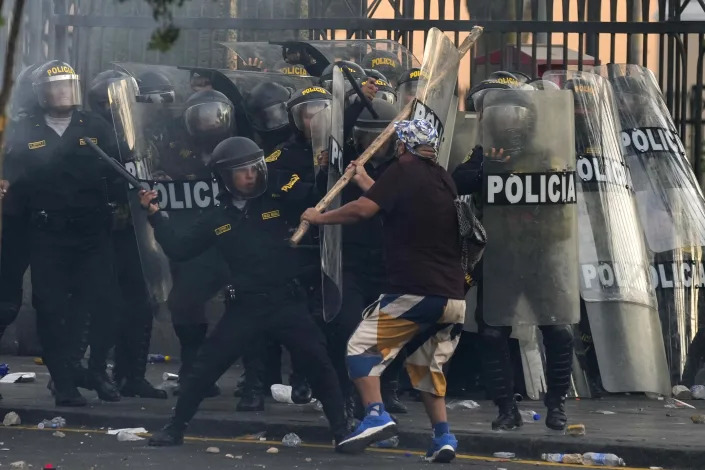
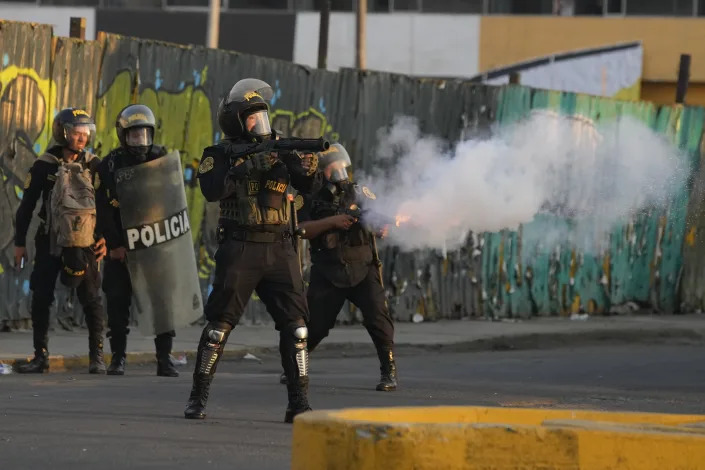
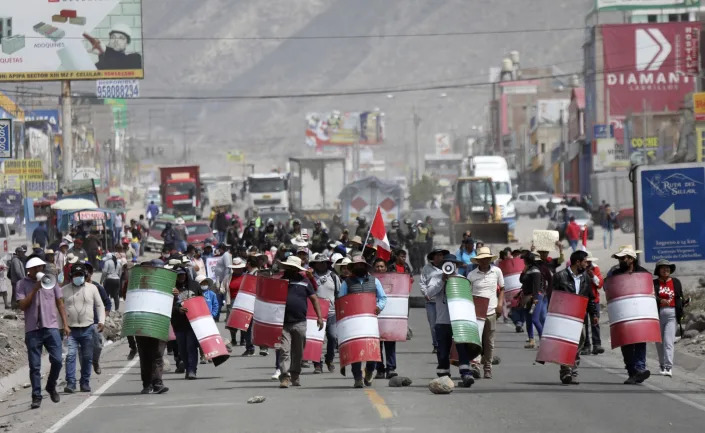
DANIEL POLITI
Sun, January 29, 2023
LIMA, Peru (AP) — When police fire tear gas at protesters demanding the resignation of Peruvian President Dina Boluarte, most run away.
A few, though, run toward the gas canisters as quickly as possible — to neutralize them.
These are the “deactivators.” Donning gas masks, safety goggles and thick gloves, these volunteers grab the hot canisters and toss them inside large plastic bottles filled with a mixture of water, baking soda and vinegar.
The deactivators made their debut in Peru street protests in 2020, inspired by protesters in Hong Kong who in 2019 unveiled new strategies to counteract the eye-stinging, breath-stealing effects of tear gas. With protesters in Lima facing a nearly daily fusillade of tear gas, more people have joined the ranks of deactivators trying to shield them and keep the demonstrations going.
Peruvians have been protesting since early December, when former President Pedro Castillo was impeached after a failed attempt to dissolve Congress. His vice president, Boluarte, immediately took over — and has faced strong opposition ever since.
Fifty-eight people have died in connection with the unrest, including one police officer. Forty-six of the deaths occurred during direct clashes between protesters and police.
The protests have exposed deep divisions in the country between the urban elites and the rural poor. Demonstrations were first largely concentrated in the south, a long-neglected region of Peru that felt a particular kinship to Castillo’s humble background as a rural teacher from the Andean highlands. But earlier this month, thousands descended on Peru's capital, and police met them with tear gas. Lots and lots of tear gas.
On Thursday, as protesters gathered in downtown Lima, Alexander Gutiérrez Padilla, 45, was giving a brief course to anyone who would listen around Plaza San Martín about how to mix vinegar and baking soda into the water and how to grab the tear gas canisters most efficiently.
“If we don’t deactivate, people disperse and the protest breaks,” Gutiérrez said. “That’s why we’re pillars of this demonstration.”
Next to him was Wilfredo Huertas Vidal, 25, who has taken it upon himself to collect donations to buy gloves and other protective equipment and hand them out to those who want to help.
“Who wants gloves? Who wants gloves?” he yelled as he stood next to several large bottles of water, gas masks and eye goggles.
When protesters descended on Lima earlier this month, old networks were reactivated. A tactic first seen in Peru in late 2020 during protests against then-President Manuel Merino resurfaced.
Vladimir Molina, 34, who participated in the 2020 protests, now runs what he calls a “brigade.” It consists of around 60 people, including paramedics, deactivators and “front-line” activists who stand in the middle of protesters and police with shields, in an effort to block any pellets or tear gas police may fire into the crowd.
“Every day more and more people are joining,” Molina said. Interest in his group is so great that he’s made it a requirement for anyone who wants to join to have their own equipment.
By tossing the hot tear gas cartridges into the water solution, “what they do is extinguish the pyrotechnical charge so the tear gas cannot come out anymore,” said Sven Eric Jordt, a professor of anesthesiology at Duke University.
Water alone should achieve what the protesters want, although the carbon dioxide created by mixing vinegar and baking soda could “form a foam bath that suffocates the charge” further, Jordt speculated.
It may be only a matter of time before authorities deploy methods to blunt the deactivators' effectiveness. Manufacturers are now developing tear gas with plastic cartridges that stick to the road so it “can’t be lifted up anymore,” Jordt said.
Fearful of being targeted by police and prosecutors, many of the deactivators prefer to remain anonymous, keeping their faces covered even when there’s no tear gas around.
Boluarte has given strong backing to law enforcement, and the government recently announced a bonus for police officers. Boluarte has characterized the work of police controlling the Lima protests as “immaculate,” despite their often indiscriminate firing of tear gas and pellets. In contrast, she says the demonstrations are violent and financed by drug-trafficking rings and illegal miners.
Andrea Fernández, 22, is new to deactivating tear gas.
“The truth is I love the adrenaline,” Fernández said shortly after grabbing a pair of gloves from Huertas and listening to the instructions closely.
She said she hadn’t been really interested in the country’s political crisis at first. Then the deaths started piling up.
“There are a lot of farmers who’ve come from lots of parts of Peru and they come here to march, face-to-face, but don’t have the necessary protection,” Fernández said.
Felix Davillo, 37, also says the casualties pushed him to become a deactivator.
“I made this decision for all the death that is going on in Puno right now,” Davillo said, referring to a region in Peru that has experienced some of the deadliest protests.
A general lack of protective equipment has also meant protesters have been injured by the widespread use of less lethal weapons.
From January 19 to 24, Doctors Without Borders treated 73 patients at the Lima protests suffering from exposure to tear gas, pellet wounds, contusions or psychological distress, the non-profit organization said.
The deactivators' increased chance of injury doesn’t scare Julio Incarocas Beliz, who grabbed one of the big water bottles in the plaza for his first day trying to diffuse tear gas.
“I served in the military and I’ve never been afraid,“ Incarocas, 28, said. “I’m fighting for my homeland.”
Sun, January 29, 2023
LIMA, Peru (AP) — When police fire tear gas at protesters demanding the resignation of Peruvian President Dina Boluarte, most run away.
A few, though, run toward the gas canisters as quickly as possible — to neutralize them.
These are the “deactivators.” Donning gas masks, safety goggles and thick gloves, these volunteers grab the hot canisters and toss them inside large plastic bottles filled with a mixture of water, baking soda and vinegar.
The deactivators made their debut in Peru street protests in 2020, inspired by protesters in Hong Kong who in 2019 unveiled new strategies to counteract the eye-stinging, breath-stealing effects of tear gas. With protesters in Lima facing a nearly daily fusillade of tear gas, more people have joined the ranks of deactivators trying to shield them and keep the demonstrations going.
Peruvians have been protesting since early December, when former President Pedro Castillo was impeached after a failed attempt to dissolve Congress. His vice president, Boluarte, immediately took over — and has faced strong opposition ever since.
Fifty-eight people have died in connection with the unrest, including one police officer. Forty-six of the deaths occurred during direct clashes between protesters and police.
The protests have exposed deep divisions in the country between the urban elites and the rural poor. Demonstrations were first largely concentrated in the south, a long-neglected region of Peru that felt a particular kinship to Castillo’s humble background as a rural teacher from the Andean highlands. But earlier this month, thousands descended on Peru's capital, and police met them with tear gas. Lots and lots of tear gas.
On Thursday, as protesters gathered in downtown Lima, Alexander Gutiérrez Padilla, 45, was giving a brief course to anyone who would listen around Plaza San Martín about how to mix vinegar and baking soda into the water and how to grab the tear gas canisters most efficiently.
“If we don’t deactivate, people disperse and the protest breaks,” Gutiérrez said. “That’s why we’re pillars of this demonstration.”
Next to him was Wilfredo Huertas Vidal, 25, who has taken it upon himself to collect donations to buy gloves and other protective equipment and hand them out to those who want to help.
“Who wants gloves? Who wants gloves?” he yelled as he stood next to several large bottles of water, gas masks and eye goggles.
When protesters descended on Lima earlier this month, old networks were reactivated. A tactic first seen in Peru in late 2020 during protests against then-President Manuel Merino resurfaced.
Vladimir Molina, 34, who participated in the 2020 protests, now runs what he calls a “brigade.” It consists of around 60 people, including paramedics, deactivators and “front-line” activists who stand in the middle of protesters and police with shields, in an effort to block any pellets or tear gas police may fire into the crowd.
“Every day more and more people are joining,” Molina said. Interest in his group is so great that he’s made it a requirement for anyone who wants to join to have their own equipment.
By tossing the hot tear gas cartridges into the water solution, “what they do is extinguish the pyrotechnical charge so the tear gas cannot come out anymore,” said Sven Eric Jordt, a professor of anesthesiology at Duke University.
Water alone should achieve what the protesters want, although the carbon dioxide created by mixing vinegar and baking soda could “form a foam bath that suffocates the charge” further, Jordt speculated.
It may be only a matter of time before authorities deploy methods to blunt the deactivators' effectiveness. Manufacturers are now developing tear gas with plastic cartridges that stick to the road so it “can’t be lifted up anymore,” Jordt said.
Fearful of being targeted by police and prosecutors, many of the deactivators prefer to remain anonymous, keeping their faces covered even when there’s no tear gas around.
Boluarte has given strong backing to law enforcement, and the government recently announced a bonus for police officers. Boluarte has characterized the work of police controlling the Lima protests as “immaculate,” despite their often indiscriminate firing of tear gas and pellets. In contrast, she says the demonstrations are violent and financed by drug-trafficking rings and illegal miners.
Andrea Fernández, 22, is new to deactivating tear gas.
“The truth is I love the adrenaline,” Fernández said shortly after grabbing a pair of gloves from Huertas and listening to the instructions closely.
She said she hadn’t been really interested in the country’s political crisis at first. Then the deaths started piling up.
“There are a lot of farmers who’ve come from lots of parts of Peru and they come here to march, face-to-face, but don’t have the necessary protection,” Fernández said.
Felix Davillo, 37, also says the casualties pushed him to become a deactivator.
“I made this decision for all the death that is going on in Puno right now,” Davillo said, referring to a region in Peru that has experienced some of the deadliest protests.
A general lack of protective equipment has also meant protesters have been injured by the widespread use of less lethal weapons.
From January 19 to 24, Doctors Without Borders treated 73 patients at the Lima protests suffering from exposure to tear gas, pellet wounds, contusions or psychological distress, the non-profit organization said.
The deactivators' increased chance of injury doesn’t scare Julio Incarocas Beliz, who grabbed one of the big water bottles in the plaza for his first day trying to diffuse tear gas.
“I served in the military and I’ve never been afraid,“ Incarocas, 28, said. “I’m fighting for my homeland.”


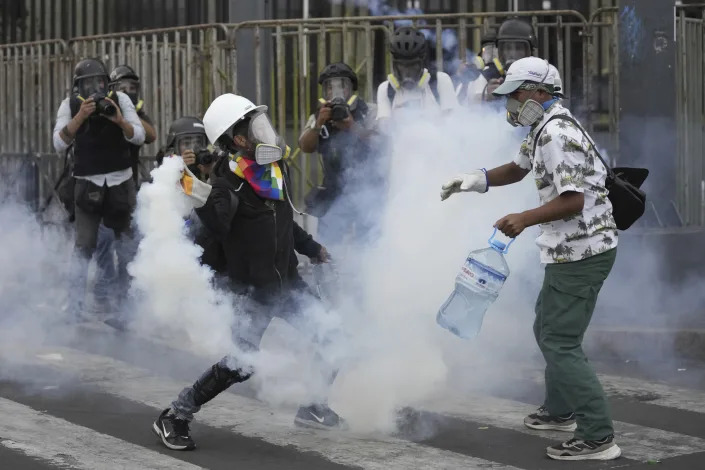
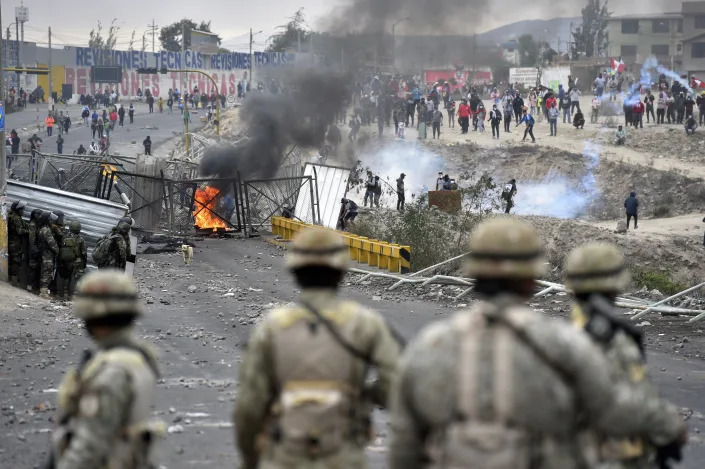
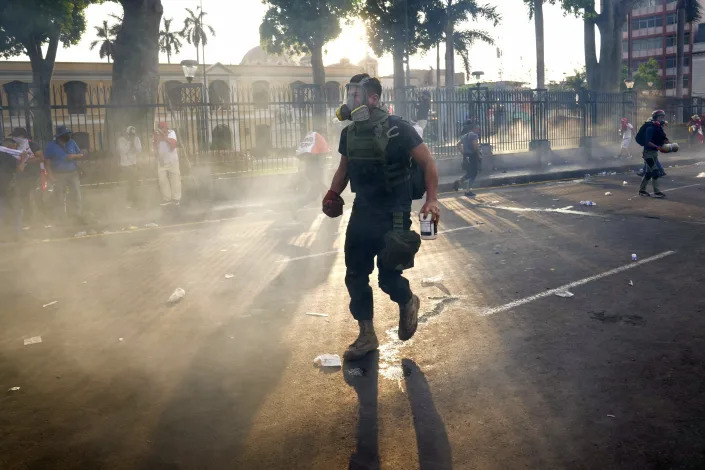



An effigy of President Dina Boluarte makes up part of a roadblock set up by demonstrators asking for the resignation of Boluarte, in Cusipata, Peru, Saturday, Jan. 28, 2023. Government officials said that police and the military will lift blockades set up around the country by supporters of former President Pedro Castillo who took to the streets after he was impeached and arrested for trying to dissolve Congress in December. (AP Photo/Rodrigo Abd)
No comments:
Post a Comment